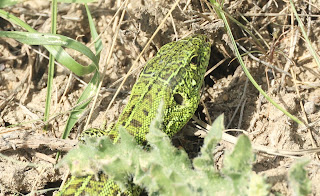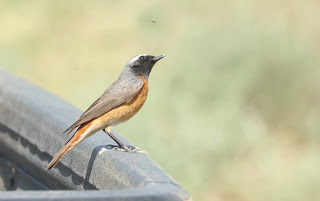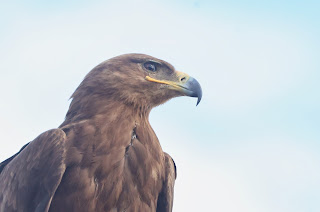Back in May I was given the opportunity to embark upon a work trip to survey for birds in Central Asia's largest country, Kazakhstan. This was a real privilege to work on a special project that has given me the experience of a life time. I was complied by Alex Poole colleague at WSP and a top bloke and a top ecologist, despite being a Villa fan.
On reflection the one thing that was most notable about the trip was the difference in habitat types and how vast and distinct they were, so I thought I would lay this blog post out by each classification of habitat and the species observed within each one.
Steppe Eagle: This Kazakhstan Steppe is such an incredible sight spanning the horizon like the grasslands of Africa or the prairies of North America. However, here they aredominated by Boehmer's cat's-tail, narrow-leaved meadow-grass, northern bedstraw, lupine clover, tuberous Jerusalem sage, and Artemisia latifolia.
The first thing that you notice is the smell of wild mint in the air, everywhere you walk you the air is perfumed with this scent.
Long-legged Buzzard: I was surprised how green the Steppe actually was, doing the research and looking at google maps and arial imagery the whole of this area looked bleak, brown, dry and uninspiring.
Demoiselle Crane: One of my main target birds I was really hoping to see, was the Demoiselle crane. We had a trio fly low over the road one morning and landed in the field with about a dozen or so other birds, not far from the our car it gave us a really good opportunity to see them up close.
One of the first birds or prey we saw after parking up and taking a short walk over the Steppe where our transect route was located was the magnificent Steppe eagle. It flew over rising just in front of us before taking off over the vagrant green Steppe.
Long-legged Buzzard: I was surprised how green the Steppe actually was, doing the research and looking at google maps and arial imagery the whole of this area looked bleak, brown, dry and uninspiring.
Demoiselle Crane: One of my main target birds I was really hoping to see, was the Demoiselle crane. We had a trio fly low over the road one morning and landed in the field with about a dozen or so other birds, not far from the our car it gave us a really good opportunity to see them up close.
Found primarily in open spaces with a wide range of visibility, there can be found living in upland areas, unlike most other cranes which can be found in wetland habitat. This crane species enjoys space and solitude, therefore their habitats vary from semi-arid savannas, grasslands, and Steppes, to high plateaus.
Ground squirrels are a really special prey species most strongly associated with the Steppe eagle. In some areas, as much as 98% of the diet reportedly can be little ground squirrels.
Dry Steppe
The Kazakh steppe, also known as the Kirghiz steppe, is itself one of the largest dry Steppe regions on the planet, covering approximately 804,500 square kilometres and extending more than 2,200 kilometres from north of the Caspian Sea east to the Altai Mountains. These grasslands lie at the southern end of the Ural Mountains, the traditional dividing line between Europe and Asia. This Steppe ecosystem is actually comprised of five different ecological zones, including forest steppe, meadow steppe, dry steppe, desertified steppe and steppe semi-desert, collectively occupying about 59% of the area of Kazakhstan.
Tawny Pipit: There are not that many pipit species at this time of year on the Steppe so the only one we saw while while out surveying was the Tawny.
A rather slim, long-tailed bird, distinctly wagtail-like in its movements, they are general sandy in coloration with their upper-parts darker than under-parts and where numerous across most of the areas we visited.
White-winged Lark: Along our survey route we found a large reservoir with some interesting fatures that we thought could be good for some of our target species. So we thought we would pull over and take look, hoping to find some waders. Instead we had a flock of European bee-eaters flying through.
European Bee Eater: These colourful birds put on a great show and even landed close and flew over our heads. It was here that the local police pulled over alongside us, Alex and I were looking at each other with some worry in our eyes before they approached our guide and spoke to them in their native Kazakh.
Relict Ground Squirrel: The local police were just curious and were friendly and approachable. They came over to take some selfies with us and shake our hands. They were blown away that we were there watching birds. I guess they don't come across many scousers out here.
Sand Lizard: Post-Soviet fires and grazing regimes have govern the abundance of a key ecosystems on the Steppe.
Intensive grazing and fire patterns across the Steppes have changed dramatically over the past decades due to the collapse of the Soviet Union in 1991, and Kazakhstan is now a global fire hotspot.
Little Bustard: There has been systematic population control of many of the mammals found on the Steppe in order to make way for grazing. Thankfully the movement, the locals and landowners are now teaming up with biodiversity and conservation charities and organisations to help manage the infrastructure programs.
Steppe Eagle: We traveled further into the Steep looking for bustards and sand grouse species spotting more Steppe eagles, white-winged larks, cranes, bee-eaters, kites and buzzards.
Common Redstart: We parked up alongside the road overlooking a long stretch of Steppe scanning for target species and making habitat notes when a common redstart alighted upon our 4x4.
Rosy Starlings: Kazakstan is famous for its horses, horse meat and horse milk is popular here and the Kazakh people are skilled horse riders. We came across many wild horses and even camels roaming the vast areas of Steppe.
Steppe Eagle: The Steppe eagle appears on the flag of Kazakhstan and is the national bird of both Kazakhstan and Egypt.
The adoption of the Steppe eagle as a national emblem is unsurprising—more than 80 percent of the bird’s population nests in Kazakhstan. The avian takes its name from the habitat in which it tends to breed, both in upland and lowland areas.
Black-bellied Sandgrouse: In habitats around the world, Steppe Eagles play an important role in nature, helping to control populations of prey animals and to maintain balance in the ecosystems where they occur.
Black Lark: The Steppe eagle is entirely migratory, probably migrating in greater numbers than any other Eagle in the world. Autumn migrations take the raptors to wintering grounds in nearby Turkmenistan and Uzbekistan, but also as far away as India, Africa, and the Middle East. The birds start to return to their breeding grounds in February. Many studies corroborate that Steppe eagles generally migrate lesser distances as they age.
Black Lark is one of the iconic birds of the Steppe of Kazakhstan and they are found in grassy areas of the Steppe, particularly in areas interspersed with scattered shrubbery or wet patches.
It was Alex who first spotted one of the trip in a wet area that we were scanning for waders and sandgrouse. The birds were pretty flighty and wasn't allowing us to approach too close.
Hobby: I was thrilled, black lark was high on my most wanted list and we managed to see several colonies throughout the trip. Our only hobby we saw was close to a river inlet that intersected between a large village and the vast expance of Steppe.
Wetlands Areas
We surveys a huge river system and delta area which is one of the largest remaining natural deltas and inland lake in Central Asia. This area supports dozens of wetland types including permanent inland delta, freshwater lake, rivers, streams or creeks, and seasonal or intermittent freshwater lakes. These vast wetlands provides a rich variety of habitats supporting a range of threatened species.
With the sound of reeling Savis' and noting marsh harrier these waterways were a great place for some late day birding.
Savi's Warbler: Males and females of Savi's Warbler in breeding plumage have plain rusty-brownish upperparts (greyish-brownish tinged in fusca subspecies), with some darker flight feathers and tail feathers.
Often tail feathers are with observable bars. Pale supercilium is a little bit notable. Underparts are more pale with whitish throat and belly, and with buffy-brownish flanks and breast. Lower tail coverts are pale buffy-whitish pale-tipped, tips are less contract than in River Warbler
Red-crested Pochard: A breeding bird here in Kazakhstan, these the male striking and unmistakable with large, rounded, rusty-orange head, long red bill, and black breast. Female rather drab but distinctive: dirty buff overall with pale cheeks, dark face, and rounded brown cap. In flight, both sexes show a thick white wing stripe and whitish underwings.
Bluethroat: Alongside the sounds of reeling Savi's where the call of bluethroat. These beautiful thrush-like birds that tends to stay hidden have dull grey upper parts, but a head-on view reveals a stunning pattern of electric blue and orange on the throat.
These wet areas were fantastic places, Alex and I spent a lot of time birding here, focusing on our target species and areas that of importance to the project.
Black Tern: We had both white-winged black terns and back terns. Their breeding habitat is freshwater marshes across from southeast Europe to Central Asia and the Russia. They usually nest either on floating vegetation in a marsh or on the ground very close to water.
Black Tern: One evening we as we surveyed a small river corridor we watched a dozen or so black tern feeding in front of us with the sound of Savi's warblers and calling bluethroats all around us. It was pretty incredible.
Marsh Sandpiper: A slender pale sandpiper with a fine, needle-like bill. Note the overall slim and elegant shape, with very long and slender greenish legs: suggests a much smaller Greenshank that’s been to ballet school. In flight appears dark above with broad white stripe up middle of back; long legs project well past tail tip.
Demoiselle Crane: Unsurprisingly we observed a few small flocks of crane in and around these wetland areas. There was one area that was outstandingly stunning, where the forests urned purple with the Kazakhstan saxaul trees. These short spiky trees have a giant heather like purple flower on them which makes them very striking.
Semi-Desert Steppe
The semi-desert Steppes in Kazakhstan are dominated by perennial shrubs, often with semi-fleshy or velvety foliage, and tussock grasses interspersed with bare ground. Low variable rainfall and extreme temperatures favour flora and fauna with drought and stress-tolerance adaptations, such as deep roots. Here they vegetation became more sparce and low in lower in diversity with more open sandy areas. Another feature of the semi-desert Steppe was the vast expanse of salt flats backed by waterworn, chalk-white cliffs.
An area that looked like a mitochondria and by the time we arrived here we could see it from the moving car as we approached. A large shimmering wet area, lush green standing out against the slaty sandy semi-desert Steppe. And birds, tons of birds flying over the sparkly water.
Black Lark: There must have been over 500 balck-winged parts in this area, an astonishing number, we concluded that it must be a breeding site where they gather in large colonies.
Also here were several black lark, dozens of white-winged black tern and wood sandpipers. Once we realised the prats might have been breeding we backed off to make some notes back in the car.
Slender-billed Gull: As we drove past the small pools of standing saline alongside the road where shimmering light bounced of the slat pans we came across our first slender-billed gulls.
The slender-billed Gull sporadically breeds in southern half of plain part of Kazakhstan in north to Sorkol lake and lower reaches of Kushum river in area between Volga and Ural rivers, and on Tengiz lake. On dispersion and migration it occurs eastward to Balkhash lake, Irtysh valley and Pavlodar Trans-Irtysh area.
Caspian Plover: A stately plover with a gentle, dovelike expression. Breeding male is stunning, with a white face and belly separated by a broad chestnut patch across the chest. Breeding female is plainer brown, and has a warm rusty-brown patch across the chest.
Non-breeding adults and juveniles are grayish-brown with pale fringes to the feathers of the upperparts, as well as a pale face and belly.
Seeing these was such a great experience, these were not only one of our target species for the work we were doing but a personal target of ours.
Horned Lark: We watched a male and female caspo plover foraging in the short vegetation and scuttling past various species of lark, including our fisrt of the trip horned lark.
Black-eared Wheatear: I can't thank Alex enough for his organisation, his calmness and his companionship. This trip was huge, full of work pressures, language barriers and some very questionable accommodation.
We stayed in what could only be called Soviet style rooms with two single beds right next to each other and me snoring and coughing through the night keeping Alex up (sorry again pal).
Red-backed Shrike: But the one thing that I will remember is how well we worked together, supporting and looking out for one another. We also managed to do a smashing job with the survey under really extreme circumstances, like absolutely no one speaking English.
Greater Short-toed Lark: The whole trip was amazing, thrilling, exciting a real life experience, one full of birding memories and good laughs.
Honey Buzzard: And for the birds, well they were spectacular, we came back with a really good bird list despite the relatively small area of Kazakhstan that we explored and surveyed.
Horned Lark: We watched a male and female caspo plover foraging in the short vegetation and scuttling past various species of lark, including our fisrt of the trip horned lark.
Black-eared Wheatear: I can't thank Alex enough for his organisation, his calmness and his companionship. This trip was huge, full of work pressures, language barriers and some very questionable accommodation.
We stayed in what could only be called Soviet style rooms with two single beds right next to each other and me snoring and coughing through the night keeping Alex up (sorry again pal).
Red-backed Shrike: But the one thing that I will remember is how well we worked together, supporting and looking out for one another. We also managed to do a smashing job with the survey under really extreme circumstances, like absolutely no one speaking English.
Greater Short-toed Lark: The whole trip was amazing, thrilling, exciting a real life experience, one full of birding memories and good laughs.
Honey Buzzard: And for the birds, well they were spectacular, we came back with a really good bird list despite the relatively small area of Kazakhstan that we explored and surveyed.



















































